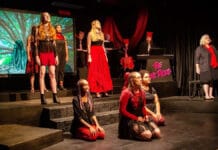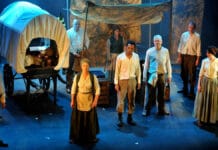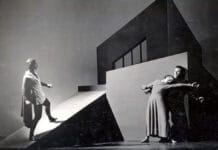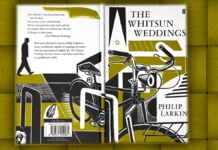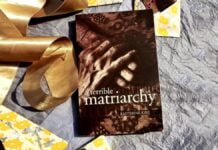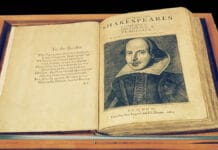Not My Best Side by U A Fanthorpe is a poem that humorously reinterprets the classical legend of Saint George and the Dragon by giving a voice to each of the three main characters depicted in Paolo Uccello’s painting of the same scene. The poem is separated into three stanzas, each providing a monologue from a different character’s point of view: the dragon, the maiden, and Saint George, respectively.
Summary
The dragon speaks first, addressing the viewer directly. He describes how he has been portrayed in the painting: as a “poor chap” with “a bleeding stump for a tail”. He complains about the unrealistic portrayal of dragons in art, stating that real dragons are majestic and powerful, not pathetic creatures like himself. Despite his grievance, he acknowledges that the artist has captured his “modesty, charm, and talents” accurately.
The second stanza features the maiden, depicted as a modern, independent woman unimpressed by Saint George’s heroic gestures. She describes how she’s tired of being portrayed as a passive victim waiting to be rescued. She criticises Saint George for his outdated chivalric ideals and lack of respect for her agency. She asserts her power and agency, suggesting that she could have easily defeated the dragon herself if she had wanted to.
In the last stanza, Saint George speaks in a colloquial, modern tone, expressing frustration with the situation. He complains about the difficulty of fighting dragons and suggests that he only took on the task because it was expected of him. He acknowledges that he’s not at his best in the painting but blames the circumstances rather than taking responsibility for his actions.
The poem subverts expectations about traditional roles within the myth, injecting a modern and critical perspective on these archetypes, gender roles, and the act of portraying itself, both in art and narrative.
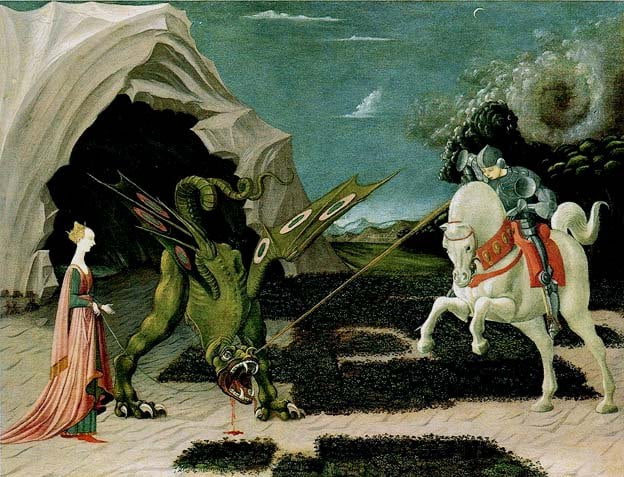
Subversion of Traditional Narratives
Fanthorpe’s poem takes a well-known story from mythology and reimagines it with a contemporary twist. By giving voice to the dragon, the maiden, and Saint George himself, the poem subverts the typical roles assigned to these characters in the legend. This subversion allows for a more nuanced exploration of power dynamics and agency.
Characterisation
The poem is notable for giving each character a distinct voice and perspective, allowing them to express personal sentiments that are at odds with their traditional representations. The dragon, maiden, and knight all narrate their version of events, which is a clever technique for exploring character motivations and biases. The dragon is portrayed as self-aware and somewhat resigned to his fate, the maiden as assertive and independent, and Saint George as brash and somewhat ineffectual. Through these characterisations, Fanthorpe critiques traditional gender roles and societal expectations.
Humour and Irony
The poem is infused with humour and irony, which entertain the reader and highlight the absurdity of the situation. Fanthorpe uses satire to critique and mock the stereotypes common in historical and literary depictions of heroes, maidens, and monsters. The dragon’s wry commentary on his portrayal, the maiden’s irreverent attitude towards Saint George, and Saint George’s exasperated complaints all contribute to the poem’s satirical tone. The poem undermines the glorification of heroism through humour and offers a tongue-in-cheek reflection on vanity, self-perception, and gender roles.
Feminist Undertones
The maiden’s monologue, in particular, has been the subject of feminist critique. Her refusal to conform to the damsel-in-distress stereotype and her interest in the dragon demonstrate an agency and independence not typically associated with female characters in traditional narratives.
Language and Structure
Fanthorpe’s use of language is precise and evocative, and she employs various poetic techniques, such as imagery and symbolism, to enrich the text. The poem is structured in three distinct monologues, where each character speaks in the first person, effectively making the characters more relatable to the reader. The diction and rhythm are suited to each character’s persona, adding depth and authenticity to their points of view.
Critical Engagement with Art
By reimagining a famous work of art, Fanthorpe invites readers to reconsider their interpretations of visual media and the stories they depict. The poem can be read as a meta-commentary on the nature of art and the subjective experience of viewing art. Just as the characters in the painting cannot control how they are portrayed, the poem implies that there is often a disconnect between the subject’s reality and the artist’s interpretation. It encourages critical engagement with cultural artefacts and challenges the notion of a single authoritative interpretation.
Modern Relevance
Despite being based on a medieval legend, Not My Best Side resonates with contemporary themes and concerns. The poem’s exploration of power dynamics, agency, and identity construction remains relevant today, where traditional narratives are constantly being challenged and reexamined.
Fanthorpe’s Not My Best Side employs humour and irony to critique artistic representation, challenge traditional gender roles, and question the nature of heroism. The poem is a commentary on how perceptions can be shaped by art and narratives, and it encourages readers to consider different viewpoints and the complexities of identity.


